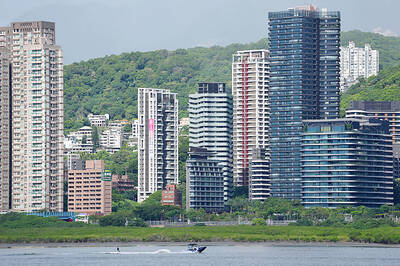Asia is giving the once-shunned nuclear power industry a second lease on life, thanks to the global energy crisis.
Governments in Japan and South Korea are removing anti-nuclear policies, while China and India are looking to build more reactors to avoid potential supply shortages and curb emissions. Even developing nations across Southeast Asia are exploring atomic technology.
The embracing of nuclear energy comes after the prices of natural gas and coal, the two fossil fuels used to generate most of Asia’s power, shot to records this year as Russia’s invasion of Ukraine upended markets. As the world shifts away from Russia, a major fuel exporter, supply are expected to remain tight and prices high well into the future.

Photo: AFP
That is making clean and reliable nuclear power attractive for policymakers and utilities eager to rein in inflation, achieve renewable energy goals and curb dependence on overseas energy suppliers.
“Old resistances are crumbling surprisingly fast,” said David Hess, a policy analyst at the World Nuclear Association(WNA). “Existing nuclear plants produce some of the cheapest electricity. The skyrocketing natural gas price has made these obvious economic advantages all the more obvious.”
It is a dramatic turnaround for the nuclear industry, which has spent the past few decades beset by cost overruns, competition from cheaper fossil fuels and stricter regulations. Delays to major nuclear projects resulted in the bankruptcy of industry pioneer Westinghouse Electric Co.
While the nuclear power comeback is global, gaining proponents from the UK to Egypt, the shift is perhaps most surprising in Asia, considering it had the closest view of the catastrophe that struck Japan more than a decade ago.
The future of the industry was still looking bright until a massive tsunami in March 2011 hit the Fukushima Dai-Ichi nuclear power plant in Japan, resulting in the worst meltdown in decades.
The incident convinced some governments that nuclear power’s risks far outweighed its benefits, with Taiwan and Germany setting deadlines to close down their fleets of plants.
Mammoth costs of building new facilities, and frequent delays, also served as deterrents.
Now, as power bills surge and nations deal with fossil fuel-induced inflation, governments are again looking to nuclear. It requires little uranium to operate, which is currently abundant, and it produces power around the clock, unlike intermittent renewable energy projects such as wind and solar.
Also boosting the industry are advances in producing smaller and cheaper nuclear technology, including small modular reactors (SMRs) which might become attractive options to tackle climate change.
That explains why Japan, which depends on imported fuel to produce most of its electricity, lastweek said that it would explore development and construction of next-generation reactors, while also pushing for the restart of more idled nuclear reactors. It is a complete turnaround for Japan, which for the past decade said it would not build new units or replace old ones.
A similar shift is taking place in South Korea.
Voters this year elected a pro-nuclear president who wants atomic energy to account for 30 percent of total energy generation, reversing the previous administration’s plan to ditch reactors.
He also vowed to make the nation a major exporter of nuclear equipment and technology, and integrate atomic power and renewable energy to push for carbon neutrality.
China, which is grappling with a historic heat wave that has resulted in power shortages in parts of the country, last week said that it would accelerate nuclear power and hydro projects.
The nation is in the midst of the largest build-out of reactors in the nuclear industry’s history to meet its insatiable energy demand, while also curbing dependence on coal-fired power plants.
China has nearly 24 gigawatts of nuclear power capacity under construction, while another 34 gigawatts is planned, WNA data showed.
If all of that comes to fruition, China would become the world’s top nuclear power producer.
Indian Prime Minister Narendra Modi’s expansion into atomic energy is also gaining momentum as India’s largest power producer looks to develop two massive nuclear power projects.
The country generates about 70 percent of its electricity using coal and about 3 percent from nuclear, but Modi is aiming to more than triple its nuclear fleet over the next decade.
Even cash-strapped nations across Southeast Asia are looking at nuclear power. Philippine President Ferdinand Marcos Jr last month told the Philippine Congress that he would explore nuclear plants to bring down power costs and boost energy sufficiency. Indonesia is planning to start its first nuclear plant in 2045, part of an ambitious goal to reach net-zero emissions by 2060.
Singapore earlier this year said that next-generation nuclear or geothermal technology could make up 10 percent of its energy mix by 2050.
While the details are hazy, that is a shift from a decade ago when the country concluded that conventional reactors were not suitable.
Not all governments in Asia are convinced. Taiwan has not changed its position to phase out nuclear power.
The nation plans to shut its reactors at the end of their 40-year lifetimes through 2025, the Ministry of Economic Affairs said last week.
Europe has shown that even having an enormous fleet of reactors does not always ensure power supply. France, one of the world’s top nuclear power producers, is grappling with record-high electricity prices due in part to a litany of reactor outages.
Meanwhile, next-generation projects such as SMRs are still years or even decades away, and do not present an immediate fix to the energy crunch, but governments and companies are moving to endorse the technology now to avoid the crises of tomorrow.
South Korean conglomerate SK Group this month said it would invest US$250 million in Microsoft Corp cofounder Bill Gates-backed TerraPower LLC.
In March, the Japan Bank for International Cooperation invested US$110 million in Nuscale Power, which is developing SMRs.
“Each country faces its own individual challenges in implementing its nuclear program,” Hess said. “But recent events have seen these obstacles disappear or shrink considerably.”

Taiwan’s rapidly aging population is fueling a sharp increase in homes occupied solely by elderly people, a trend that is reshaping the nation’s housing market and social fabric, real-estate brokers said yesterday. About 850,000 residences were occupied by elderly people in the first quarter, including 655,000 that housed only one resident, the Ministry of the Interior said. The figures have nearly doubled from a decade earlier, Great Home Realty Co (大家房屋) said, as people aged 65 and older now make up 20.8 percent of the population. “The so-called silver tsunami represents more than just a demographic shift — it could fundamentally redefine the

Businesses across the global semiconductor supply chain are bracing themselves for disruptions from an escalating trade war, after China imposed curbs on rare earth mineral exports and the US responded with additional tariffs and restrictions on software sales to the Asian nation. China’s restrictions, the most targeted move yet to limit supplies of rare earth materials, represent the first major attempt by Beijing to exercise long-arm jurisdiction over foreign companies to target the semiconductor industry, threatening to stall the chips powering the artificial intelligence (AI) boom. They prompted US President Donald Trump on Friday to announce that he would impose an additional

China Airlines Ltd (CAL, 中華航空) said it expects peak season effects in the fourth quarter to continue to boost demand for passenger flights and cargo services, after reporting its second-highest-ever September sales on Monday. The carrier said it posted NT$15.88 billion (US$517 million) in consolidated sales last month, trailing only September last year’s NT$16.01 billion. Last month, CAL generated NT$8.77 billion from its passenger flights and NT$5.37 billion from cargo services, it said. In the first nine months of this year, the carrier posted NT$154.93 billion in cumulative sales, up 2.62 percent from a year earlier, marking the second-highest level for the January-September

Asian e-commerce giant Shein’s (希音) decision to set up shop in a historic Parisian department store has ruffled feathers in the fashion capital. Anger has been boiling since Shein announced last week that it would open its first permanent physical store next month at BHV Marais, an iconic building that has stood across from Paris City Hall since 1856. The move prompted some French brands to announce they would leave BHV Marais, but the department store had already been losing tenants over late payments. Aime cosmetics line cofounder Mathilde Lacombe, whose brand was among those that decided to leave following